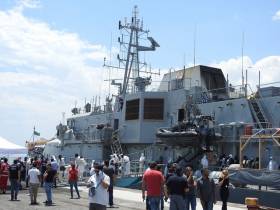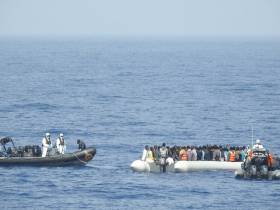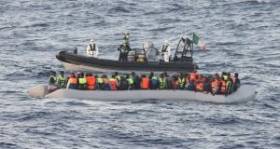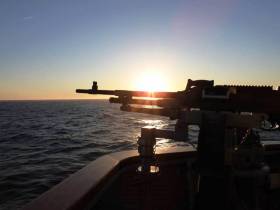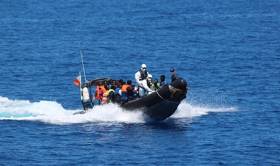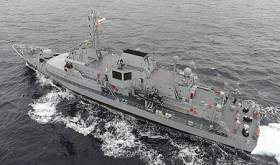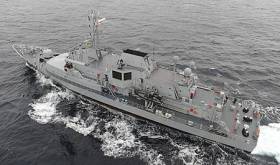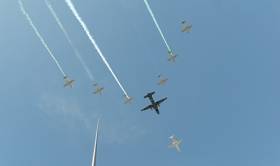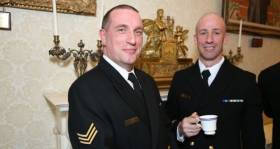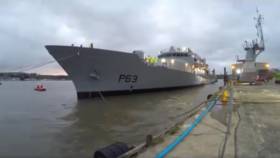Displaying items by tag: Navy
LÉ Róisín Transfers Total of 375 Migrants to Italian Port
#RescueTransfer - LÉ Róisín has transferred a total of 375* migrants on Thursday to the Sicilian east coast port of Catania, following a request from the Italian Maritime Rescue Co-Ordniation Centre.
This follows the completion of a rescue the previous day also by LÉ Róisín of 139* migrants and the transfer of a further 236* from an NGO ship, the Aquarius.
Once all migrants were on-board the LÉ Róisín they were given food, water and medical treatment.
The Naval Service OPV ship had arrived at Catania yesterday morning where the the migrants were disembarked by 1.00pm and are now being administered by the Italian authorities.
Since the naval vessel was deployed from Ireland, to begin search and rescue (SAR) duties that began two months ago (tomorrow) so far a total of 782* people have been rescued and 683 transferred.
The LÉ Róisín has since departed Sicilly for Valletta for refueling and resupply, while awaiting further operations.
#ThirdRescue - Minister of State with Special Responsibility for Defence, Paul Kehoe at the weekend praised the crew of LÉ Róisín under the command of her captain, Lieutenant Commander Ultan Finegan, for their continued role in assisting with the migrant crisis in the Mediterranean.
The Minister confirmed that LÉ Róisín has completed three operations on Saturday. One of the operations involved the rescue of 123 migrants from a 12m long rubber vessel craft 28 nautical miles Northwest of Tripoli. Unfortunately during the course of the rescue one deceased male migrant was also recovered from the rubber vessel craft. The other two operations involved the transfer of 101 migrants from an Italian ship and 123 migrants from a German ship to the Irish Naval Vessel.
The Minister stated "I am deeply saddened by this loss of life and I want to thank the crew of LÉ Róisín for their ongoing contribution and assistance to those in distress in the Mediterranean."
The Minister went on to say that "our thoughts and prayers are with the family of the deceased male, the survivors and the rescuers involved in today’s operations. I would like to thank the crew of LÉ Róisín for their work in the Mediterranean and to wish them continued success in their endeavours".
The rescue today brings to 642 the number of migrants rescued by LÉ Róisín since it commenced operations on 12 May 2016.
Two Operations by LÉ Róisín Rescue Almost 400 Migrants
#SecondSAR - LÉ Róisín successfully searched and rescued (SAR) yesterday 274* migrants from a 18m long wooden vessel craft 39 nautical miles north-west of Tripoli, Libya. The rescue was at the request of the Italian Maritime Co-Oridnation Centre.
Immediately following the first rescue the LÉ Róisín was re-tasked to assist with a further rescue operation of 121* migrants 29 nautical miles north north-west of Tripoli from a 12m long rubber craft.
The rescue commenced at 12.24 pm and all migrants were on board by 2.56pm and are now receiving food, water and medical treatment where required.
Both taskings have now been completed and LÉ Róisín currently has 394 migrants on-board including 78 female.
LÉ Róisín is now transferring the migrants to the port of Catania where they will be administered by the Italian authorities.
*Figures for the operation are provisional until confirmed by the Italian authorities.
The LÉ Róisín departed Naval Service Headquarters in Haulbowline, Cork to assist the Italian Authorities in the humanitarian SAR operations in the Mediterranean. The first such operation began on 11th of May.
Why Has No Politician Expressed Concern In The Dáil About The 'Strategic Implications' Threatening The Naval Service?
Why has no politician of any hue, Government or Opposition, of any party or of the Independents, raised concern in the Dáil about the strategic implications for the State of the threat to a fully operational Naval Service and its joint operations with the Air Corps? Scroll down to listen to the podcast below.
Why has no one questioned the Taoiseach who, in the formation of the new Government, took to his own responsibility the Department of Defence, about these issues? The Department has stated, clearly and unambiguously, in public that Naval and Air Corps joint operations, including those directed towards marine counter-terrorism, replenishment of Naval vessels at sea and other operations, are under threat.
The Haulbowline Naval Base is “an important strategic location for the Irish Defence Forces..”
“It is the only Naval Service base in Ireland..” The threat to it “cannot be an acceptable situation for the necessary functioning of a fully operational Naval Base.”
Those are not my opinions. They are those of the Department of Defence.
And yet, they do not seem to worry the members of our National Parliament.
Not a mention in the Dáil, the assembly of the duly-elected representative of the people, no concern expressed about the “strategic implications” for the country’s Navy and Air Corps.
Either the politicians have no interest in the defence of the nation or they care little about the maritime defence force and its joint operations with the Air Corps.
I live in Cork Harbour and when I look out my kitchen window I see three wind turbines powering chemical factories close by and I can see the operations of several of these plants every day from my home, so I am well used to the heavy industrialisation of the harbour. However, this is an issue of the operations of the Navy and Air Corps, identified by the Department of Defence as having "strategic implications for the State" and which, as the Department has said, makes it a nationalo, not a local issue.
This week on THIS ISLAND NATION radio programme which you should listen to here, the Managing Director of the commercial company which is posing those identified threats to the Naval Service and Air Corps, tells me that the Services should “compromise” with the operations of his company, which will co-operate with them.
In my long years of journalism, half-a-century at this stage, I have never before heard any company suggest that the nation’s defence forces should have to compromise with a commercial operation, which is not a benign, beneficent public service but an international operation with a profit motive. I had presumed that the Defence Forces are vital to the structure of a democratic nation and should be considered above such pressure from commercial interests.
John Ahern, Managing Director of Indaver Ireland, whose incinerator proposed for Ringaskiddy, close to the Naval Base, has been described by the Department of Defence as posing those unacceptable strategic implications for the Navy and Air Corps, agreed to be interviewed by me on this specific issue. He had extended the invitation to interview him. In the course of it he expressed respect for the Navy, but told me that the State, in regard to his company’s proposals, had two tasks – management of waste and operation of the Naval Service. I expressed surprise that he equated the two and reminded him that, during an accident causing explosion and fire at the Indaver plant at Antwerp Port earlier this year, all those in the vicinity were told to “stay indoors.” Was he suggesting that the Navy would have to “stay indoors” in the event of an accident at his plant? There is only one road servicing the Naval Base on Haulbowline, which the proposed incinerator would be built alongside. He accepted that there is no guarantee against accidents, even though his company theoretically maintains that there would be none which would impact on the Navy and he indicated that it would be a matter for the Naval Service to decide its response if there was an accident. He said his company had suggested an alternative escape route through nearby premises of the National Maritime College/IMERC, though he also said that people in that area, just across the road from the proposed incinerator site, might have to be told to “stay indoors” in the event of an accident.
We did not agree, as I believe that the Naval Service should be of priority importance to the nation and its operations should not be subject to any threat from commercial interests and that there should be no strategic implications for it and the Air Corps, which has said that incinerator operations will cause a ‘no fly zone’ to be imposed over the Naval Base.
I was overly concerned with Naval Service operations, in his view.
I do not agree.
Mr. Ahern appeared confident of gaining approval from Bord Pleanala, the national planning board, to proceed with the incinerator construction after a public hearing which has concluded and a decision is awaited.
Can it be that this Board, unaccountable to anyone, now has the power to decide on future Naval Service and Air Corps operations?
Can this be acceptable in an independent nation, that a planning board and not the Government, should have the power to decide on the future operations of Defence Forces?
Also on the programme, the President of the Nautical Institute, the world representative organisation for professional seafarers, says that Ireland needs a strong maritime voice. I agree with this view expressed by Captain Robert McCabe
Regrettably, it seems that a strong voice of concern about the “strategic implications” for the “fully operational” maritime defence force, the Naval Service and it Air Corps operational partners, is not present in Dáil Eireann.
Listen to the podcast below.
#FirstRescue - The crew of LÉ Róisín under the command of her captain, Lieutenant Commander Ultan Finegan, were praised by Minister of State for Defence, Mr Paul Kehoe, T.D.in assisting with the migrant crisis in the Mediterranean.
The Minister commenting yesterday stated that "the Naval Service completed their 1st successful rescue mission this morning with the rescue of 125 migrants approximately 40 nautical miles North East of Tripoli. The 125 migrants comprising 107 men and 18 women were retrieved from an inflatable craft earlier today. “
The Minister went on to say that " the Government have approved the return of the Naval Service to the Mediterranean to assist the Italian authorities in tackling this very difficult humanitarian crisis. I would like to thank the crew of LE Róisín for their outstanding work in the Mediterranean today and to wish them continued success in their endeavours".
The operation demonstrates clearly the value of our participation in this important humanitarian response.
#Roisin2Med - Minister for Defence, Mr. Simon Conveney, T.D., announced today that L.É. Róisín will depart the Naval Base, Haulbowline on Sunday, 1st May 2016, to assist the Italian authorities in the search and rescue activities in the Mediterranean.
Earlier this month the Government approved the despatch of an Irish Naval vessel to the Mediterranean. Following the Government Decision the Minister commented “The humanitarian crisis arising in the Mediterranean as a result of the Migrant crisis continues to be of great concern to Ireland and to our EU partners”.
L.É. Róisín will be despatched with a crew comprising some sixty (60) personnel of the Permanent Defence Force under the command of her captain, Lieutenant Commander Ultan Finegan. The Government anticipate that the Naval Service will be deployed in the Mediterranean until mid-July, dependent on the operational demands and requirements arising, and may then be followed by further deployments.
The Minister went on to say “I believe that we should continue to support Italy in a practical manner as far as possible and the Italian authorities have indicated that ongoing support is welcome”.
The Minister added “L.É. Róisín is ready to continue the remarkable work carried out by L.É. Eithne, L.É. Niamh and L.É. Samuel Beckett in 2015. During the course of their deployments a total of 8,592 migrants were rescued.”
#OPVtoMed - Minister for Defence, Mr. Simon Coveney through the approval of the Government is to despatch the Naval Service OPV L.É. Róisín to the Mediterranean.
The OPV with a crew of approximately sixty personnel of the Permanent Defence Force are to undertake humanitarian search and rescue tasks in the region, subject to finalisation of operational arrangements.
Following the Government Decision the Minister commented “The humanitarian crisis in the Mediterranean continues to be of great concern to Ireland and to our EU partners. I am anxious that we would resume support to Italy in the search and rescue activities in the Mediterranean”.
The Minister went on to say that “Subject to finalisation of operational arrangements, a Naval Vessel will be despatched to the Mediterranean within the next month.”
The proposed deployment will involve naval vessel rotation. Subject to the operational demands and requirements of the mission, it is intended that there will be two rotations (i.e. 3 Naval Service vessels deployed) with each deployment lasting approximately 12 weeks.
The Minister went on to say “The despatch of an Irish naval vessel represents a tangible and valuable Irish national contribution to assisting with the continuing migration crisis in the Mediterranean.”
#Navy@1916 – Representing the Naval Service at the 1916 Easter Rising centenary parade held in Dublin were personnel from the navy and a related fishery patrol aircraft, writes Jehan Ashmore.
In a rare Air Corps Fleet Fly Past display totalling 17 aircraft, this included the largest aircraft, a Casa CN 325 Maritime Fisheries Patrol craft.
The fly-over of the capital’s main thoroughfare of O’Connell Street, is where the General Post Office (the G.P.O.) in 1916 formed the headquarters of the rising and was too the focal point of Easter Sunday's historic State centenary commemoration.
The blue painted Casa aircraft, in which there are two, works in close conjunction with the Naval Service to provide an aerial platform for patrolling the Irish Economic Zone. The area of this zone is approximately 132,000 square miles or 16% of the total EU sea fisheries.
Also in the capital over the Easter weekend were docked the Naval Service coastal patrol vessel, CPV LÉ Ciara along with the larger offshore patrol vessel, OPV LÉ Samuel Beckett. Both vessels had arrived on the Good Friday and were opened to the public to visit.
The pair were berthed at Sir John Rogersons Quay, where almost a hundred years this stretch of the Liffey water saw HMY Helga shell key rebel positions during the rising. The Kingstown (Dun Laoghaire) Harbour based vessel that was dispatched to Dublin, would later became the Irish Free State’s fishery research vessel Muirchu and also a career in the fledging navy as the LÉ Muirchu.
Easter Sunday’s parade involved more than 3,700 personnel from the Defence Forces including the Army and Emergency Services and respectively involving 78 vehicles. Among those marching were military bands and colourful flag parties. On that note lifeboat crew members representing stations nationwide of the RNLI were accompanied by a trailer-towed new Atlantic 85 lifeboat.
Returning to vessels on the water, it was the LÉ Ciara that was first to return to patrol duties following the conclusion of the parade.
The leadship of the current batch of ‘Beckett’ OPV90 class vessels along with LÉ James Joyce is to be joined by a third and final sister, LÉ William Butler Yeats which was floated-out of a UK shipyard hall before St. Patrick’s Day. At that stage the OPV was without a mainmast which can be seen (see photo) at the fitting-out quay of Babcock Marine & Technology located in Appledore, north Devon.
Naval Service Paid Tribute by President in Rescuing Migrants
#PresidentTribute - Naval Service members were paid tribute by President Michael D Higgins for rescuing migrants trying to get to Europe by crossing the Mediterranean, writes The Irish Times.
About 200 members of the Naval Service, and others from the Defence Forces, were invited to a special St Patrick’s Day reception at Áras an Uachtaráin.
Personnel that crewed the LÉ Eithne, LÉ Niamh and LÉ Samuel Beckett, and who took in excess of 8,000 migrants from waters attended. For more click here.
Two of the naval vessels, Afloat adds, OPV's LÉ Niamh and LÉ Samuel Beckett berthed in Dublin yesterday along the Liffey quays. Also berthed in close proximity the French Navy OPV Flamant which in on a visit to the capital for the festivities.
#ThirdOPV90 - According to NavalTechnology.com, the Naval Service has reportedly floated out the third and final OPV90 / Samuel Beckett-class newbuild LÉ William Butler Yeats (P63).
A total of two Samuel Beckett-class OPVs were ordered by Ireland's Department of Defence under a £81m contract from Babcock Marine in October 2010, with the option of a third vessel.
In June 2014, the department exercised the option under the original contract to place an order for the third OPV, which was scheduled for delivery in the middle of this year.
Float out of L.É. William Butler Yeats time lapse videoFloat out of L.É. William Butler Yeats time lapse video
Posted by Irish Naval Service on Friday, 11 March 2016
Designed by Vard Marine, the OPVs replace three earlier vessels, the 'Deirdre' Class LE Emer, LE Aoife and LE Aisling, which were commissioned with the Irish Naval Service between 1978 and 1984. To read more click here.
Afloat adds the second 'Beckett' class OPV90 LE James Joyce (P62) was last year commissioned into service and named in a joint ceremony held in Dun Laoghaire Harbour.


























